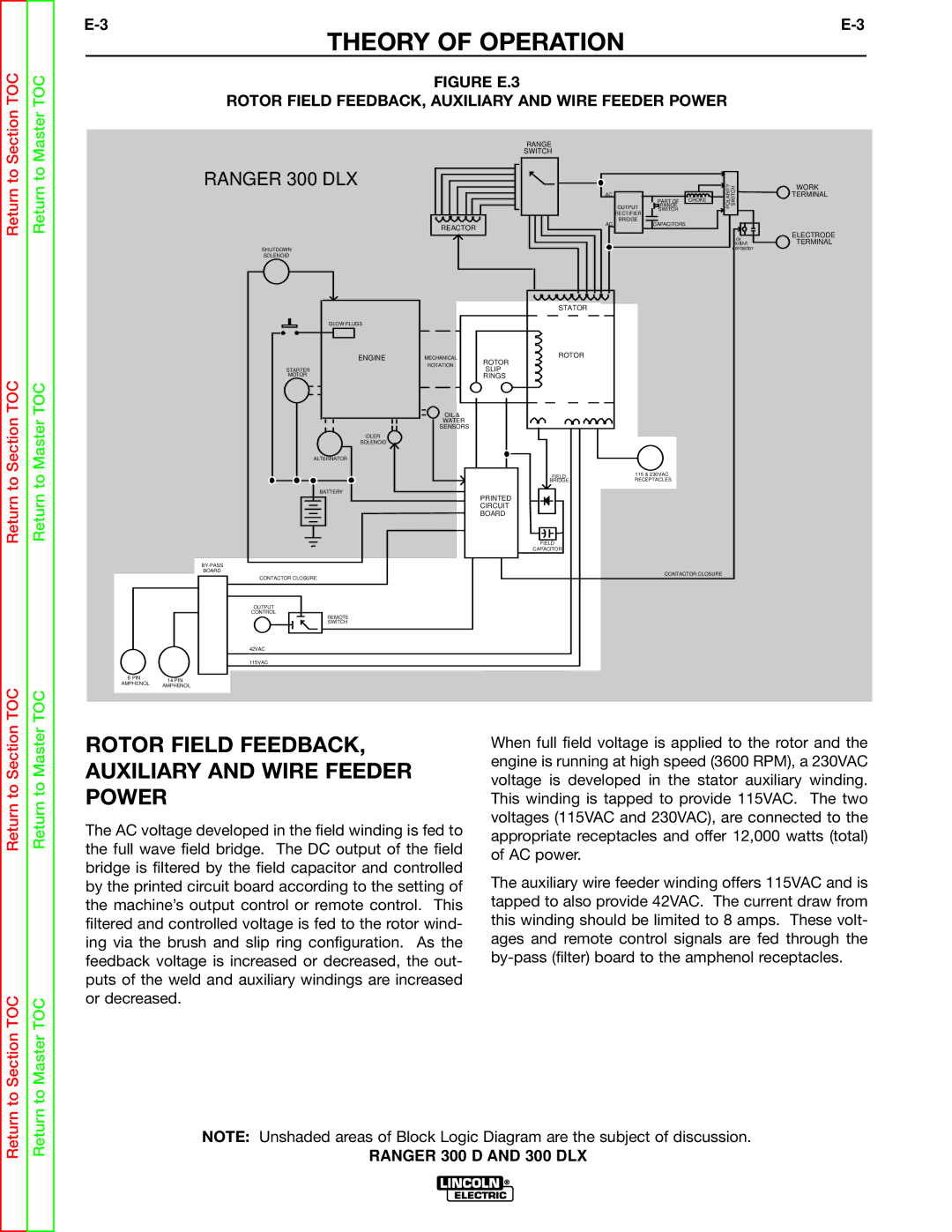Safety Depends on You
Ranger TM300 D and 300 DLX
Safety
California Proposition 65 Warnings
Electric Shock can kill
Welding Sparks can cause fire or explosion
Précautions DE Sûreté
Ranger 300 D and 300 DLX
Master Table of Contents for ALL Sections
Table of Contents Installation Section
Installation
Technical Specifications Ranger 300 D and 300 DLX
Safety Precautions
Location and Ventilation
Storing
Stacking
PRE-OPERATION Engine Service
Battery Connections
Gases from Battery can explode
Fuel
Engine Coolant
Remote Control
High Frequency Generators for TIG Applications
Welding Terminals
Electrical Connections
Auxiliary Power RECEPTACLES, PLUGS, and HAND-HELD Equipment
Welding Cable Connections
Table A.1
Total Combined Length of Electrode and Work Cables
Premises Wiring
Figure A.2 Connection of Ranger 300 to Premises Wiring
Ranger 300 D and 300 DLX
Table of Contents Operation Section
Operating Instructions
Safety Instructions
Operation
Design Features ALL Models
For Auxiliary Power
Other Features
General Description
Additional Features
Ranger 300 D K1522-1
Controls and Settings
WELDER/GENERATOR Controls
Operation
Engine Controls
Figure B.2 Engine Controls
Operation
Engine Operation
Before Starting the Engine
BREAK-IN Period
Cold Weather Starting and Operation
Stopping the Engine
Welding Operation
AC/DC TIG Constant Current
Welding
DC Wire Feed Welding CV with Ranger 300 DLX
Pure EWP Range Appropriate Tungsten Diameter Switch Settings
DC Wire Feed Welding CV with Ranger 300 D
Electrode Wire Speed Approximate
Summary of Welding Processes and Machine Settings
Summary of Welding Processes and Machine Settings
Auxiliary Power
Simultaneous Welding and Power Loads
120/240 V Dual Voltage Receptacle
Duplex Receptacles
Table of Contents Accessories
General Options Accessories
TIG Welding Options Accessories
Connection of Lincoln Electric Wire Feeders
ING Terminals Always on
PIN
Remotely Controlled
ING Terminals Remotely Controlled
To Work
Return
Ranger 300 D and 300 DLX
Ranger 300 D and 300 DLX
Table of Contents Maintenance
Safety Precautions Kubota Engine Maintenance Schedule
Frequency
Routine and Periodic
Maintenance
Engine Maintenance
Fuel Feedfuel Feedpumppumplever
Battery Maintenance
To prevent Electrical Damage when
Welder / Generator Maintenance
Charging the Battery
Figure D.3 Major Component Locations
Ranger 300 D and 300 DLX
Table of Contents Theory of Operation Section
BATTERY, STARTER, Engine
Theory of Operation
Glow PLUGS, Engine
PROTECTION, ROTOR, Stator
Rotor Field FEEDBACK, Auxiliary and Wire Feeder Power
Weld WINDING, Reactor and Range Switch
Figure E-4 Weld WINDING, Reactor and Range Switch
Return to
Ranger 300 D and 300 DLX
Table of Contents Troubleshooting & Repair Section
Troubleshooting & Repair
HOW to USE Troubleshooting Guide
PC Board Troubleshooting Procedures
Troubleshooting Guide
Output Problems
On page F-6
Output Problems
Field Winding Voltage Test
Troubleshooting Guide
No DC welding output. AC welding Make sure the polarity mode
Troubleshooting & Repair
Engine Problems
Volts is normal. If 12VDC is
Problems Possible Areas
Symptoms Misadjustments Course of Action
High Speed Solenoid Resistance Test
Perform the Fuel Shutdown
Shutdown Solenoid Resis
Function Problems
Perform the Auxiliary
12VDC is
Engine charging system
Battery does not stay charged Check for loose or faulty con
Nections at the battery
Welding Problems
Materials Needed
Rotor Resistance Test
Test Description
Conduct the test with the engine OFF
Test Procedure
Rotor Resistance Test
Output Rectifier Bridge Test
Output Rectifier Bridge Test
Conduct this test with the engine off
Fuel Shutdown Solenoid Resistance Test
Fuel Shutdown Solenoid Resistance Test
Figure F.3 Plug J12 Location
High Speed Solenoid Test
High Speed Solenoid Test
Engine Throttle Adjustment Test
Engine Throttle Adjustment Test
Conduct this procedure with the engine OFF
Figure F.7 High Idle Adjustment
Frequency Counter Method
Oscilloscope Method
Auxiliary and Field Winding Test
To test the 230 VAC winding
Auxiliary and Field Winding Test
To test the 115 VAC winding
To test the field winding
Figure F.11 14-PIN Amphenol PIN Assignments
To test the feeder winding Ranger 300 DLX Models
Rotor Voltage Test
Test Procedure
Rotor Voltage Test
Charging Circuit Test
Alternator Test Procedure
Charging Circuit Test
High Idle no Load Output Control AT Maximum
Scope Settings
Normal Open Circuit Voltage Waveform 115VAC Supply
Machine Loaded to 250 Amps AT 30VDC
Typical DC Weld Output Voltage Waveform CV Mode High TAP
Machine Loaded
Typical DC Weld Output Voltage Waveform
Machine Loaded to 250 Amps AT 25 VDC
Typical AC Weld Output Voltage Waveform
Machine Loaded to 250 Amps AT 25VDC
Abnormal Open Circuit DC Weld Voltage Waveform
Abnormal Open Circuit Weld Voltage Waveform High CV Mode
Normal Open Circuit Weld Voltage Waveform High CV Mode
Normal Open Circuit DC Weld Voltage Waveform
Normal Open Circuit AC Weld Voltage Waveform
Brush Removal and Replacement
Description
Brush Removal and Replacement
Procedure
Section TOC
Field Capacitor AND/OR Rectifier Bridge Removal Replacement
Replacement
Field Capacitor AND/OR Rectifier Bridge Removal
To Section TOC
Control Board Removal and Replacement
Control Board Removal and Replacement
Figure F.16 Printed Circuit Board Location
To Section TOC
Output Rectifier Bridge Removal Replacement
Output Rectifier Bridge Removal and Replacement
Figure F.17 Output Rectifier Connections
Reassembly
Description
Output Capacitor Bank Removal and Replacement
Ranger 300 DLX only
Output Contactor Removal and Replacement Ranger 300 DLX only
Output Contactor Removal and Replacement
Figure F.19 Output Contactor Location
Troubleshooting & REPAIRs
Stator AND/OR Rotor Removal and Replacement
Stator AND/OR Removal and Replacement
Figure F.21 Component LOCATIONS, STATOR/ROTOR Removal
Stator Removal Procedure
Stator AND/OR Rotor Removal and Replacement
Rotor Removal Procedure
Front Panel
Reassembly Notes
Lead Reconnection Checklist Engine
Retest After Repair
Electrical Diagrams
Wiring Diagram Ranger 300 D Code
R I N G D I a G R a M R a N G E R 3 0 0 D
Wiring Diagram Ranger 300 DLX Code
R I N G D I a G R a M R a N G E R 3 0 0 D L
Wiring Diagram Ranger 300 DLX
Schematic Control PC Board
PC Board Assembly Control Board
Schematic Bypass PC Board
PC Board Assembly Bypass Board
SVM Error Reporting Form

